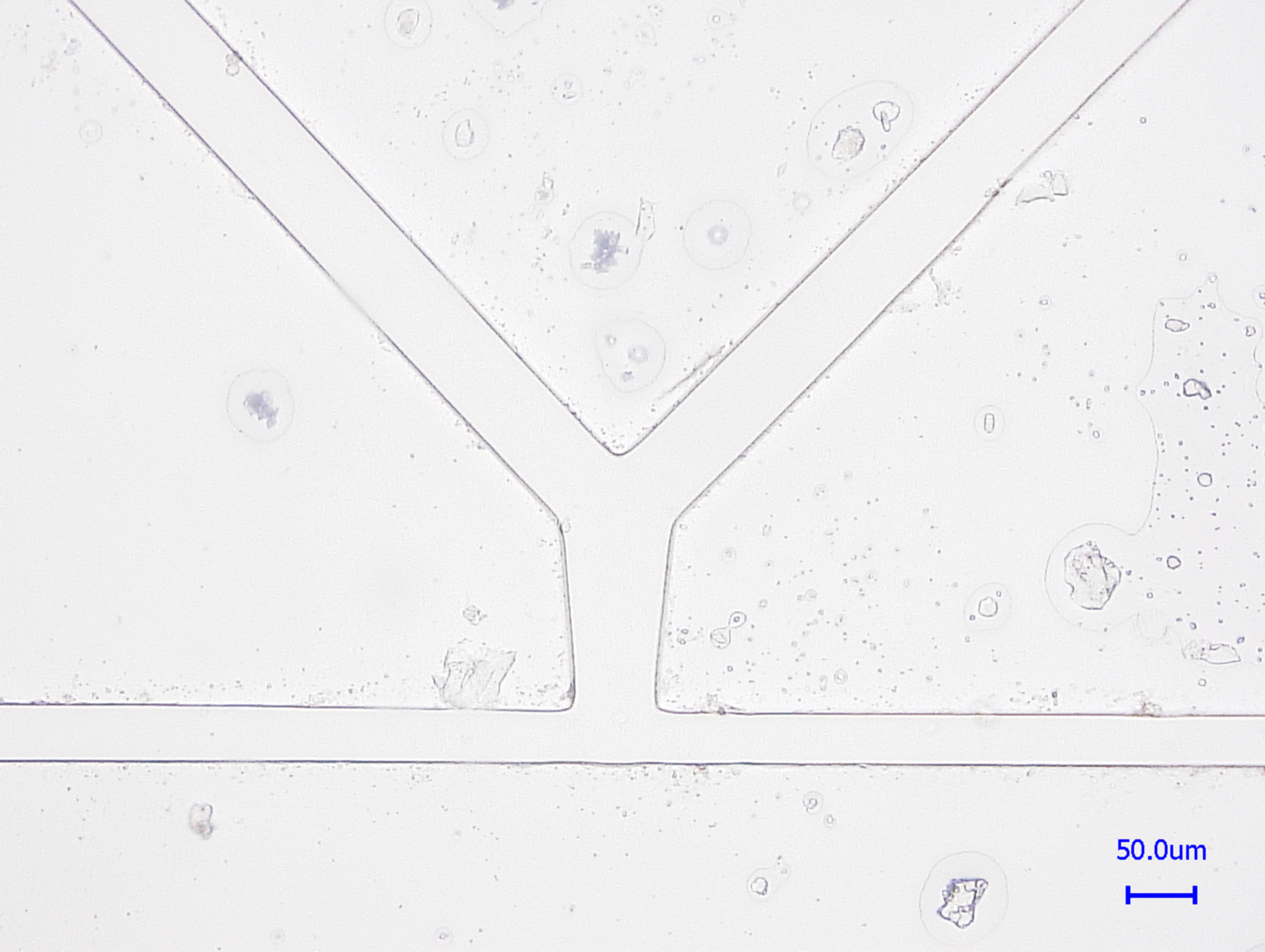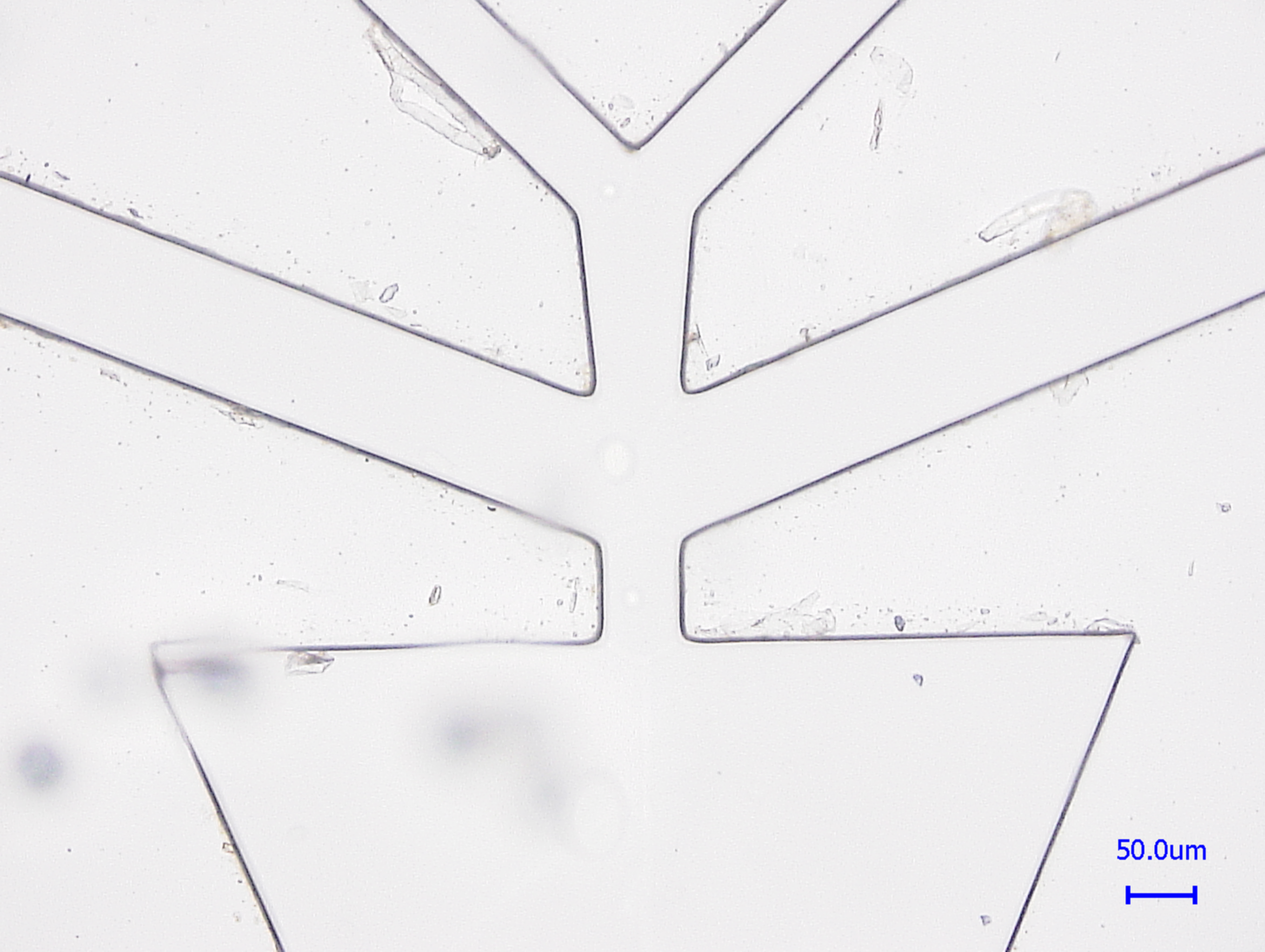Team:BIOTEC Dresden/Methods Vesicles
From 2009.igem.org
| (32 intermediate revisions not shown) | |||
| Line 2: | Line 2: | ||
=== Vesicles - Methods === | === Vesicles - Methods === | ||
| - | |||
| - | + | ==== Setup of the microfluidic system ==== | |
| - | |||
| - | The chamber | + | The microfluidic system consists of a flow chamber made of Polydimethylsiloxane (PDMS) and a pump system that controls the flow rates of the various liquids into the chamber. Droplets are created within a defined space in the chamber and are propagated along a grid that allows containment and imaging. Two types of chambers have been used, differing in the geometry of the space where droplets were produced. One featured a T-junction, and the other one a V-junction (Fig1). |
| - | |||
| + | Fig1: Different geometries of the intersection between aqueous and oil phase in flow chambers | ||
| + | {| | ||
| + | | [[Image:tchamber2.jpg|thumb|400|alt=t shaped junction|T shaped junction]] | ||
| + | | [[Image:Vchamber.jpg|thumb|400|alt=v shaped junction|V shaped junction]] | ||
| + | |} | ||
| - | + | [[Image:Silicon wafer.jpg|200px|thumb|right|Silicon wafer we used for microfluidics chamber preparation]] | |
| + | Production of flow chambers: | ||
| + | * mix PDMS and curing agent in 10:1 ratio | ||
| + | * degas and pour on wafer with etched microstructures | ||
| + | * polymerize on heat plate at 150 ºC for 30 min | ||
| + | * add unpolymerized PDMS mixture to points on microstructure where microtube inlets are to be pierced | ||
| + | * polymerize on heat plate at 150 ºC for 30 minutes | ||
| + | * remove polymerized PDMS from wafer, cut to fit onto glass cover slide (24 x 60 mm), and use clean needles (0.8 mm) or laser cutter (Trotec Speedy 100TM) to pierce tube inlets | ||
| + | * ionize PDMS and glass slide in plasma chamber for 30 sec to make it reactive | ||
| + | * align PDMS on glass slide and seal | ||
| + | * seal irreversibly by heating on plate at 60ºC for 6 hours | ||
| - | + | This video shows the laser cutting of the microtube inlets: | |
| - | + | <html> <object width="425" height="344"><param name="movie" value="http://www.youtube.com/v/gWoev1RP9SU&color1=0xb1b1b1&color2=0xcfcfcf&hl=en&feature=player_embedded&fs=1"></param><param name="allowFullScreen" value="true"></param><param name="allowScriptAccess" value="always"></param><embed src="http://www.youtube.com/v/gWoev1RP9SU&color1=0xb1b1b1&color2=0xcfcfcf&hl=en&feature=player_embedded&fs=1" type="application/x-shockwave-flash" allowfullscreen="true" allowScriptAccess="always" width="425" height="344"></embed></object> </html> <br> | |
| - | |||
| - | + | The pumping system (ceDOSYS SP-4) allows to control of syringes filled with aqueous material and surfactant treated with mineral oil, respectively. The syringes access the chamber via the tubing inlets. Two inlets are used to pump in material in the aqueous phase; the remaining one is used for the oil phase. The flow rates of the syringes are controlled via a ceDOSYS user interface software. | |
| - | + | Control via pump system: | |
| - | + | * two syringes are loaded with 1ml each of material in the aqueous phase; during the first trial, distilled water | |
| - | + | * another is filled with a 1ml solution of 0.5% span 80 in oil | |
| - | + | * use flow rate on ceDOSYS interface to flood the chamber first with oil phase | |
| - | + | * gradually introduce aqueous phase and modify rates of both phases until the shear stress breaks the aqueous phase into droplets at the T- or V- junctions in the respective chambers | |
| - | + | ||
| - | + | ||
Latest revision as of 03:50, 22 October 2009
Vesicles - Methods
Setup of the microfluidic system
The microfluidic system consists of a flow chamber made of Polydimethylsiloxane (PDMS) and a pump system that controls the flow rates of the various liquids into the chamber. Droplets are created within a defined space in the chamber and are propagated along a grid that allows containment and imaging. Two types of chambers have been used, differing in the geometry of the space where droplets were produced. One featured a T-junction, and the other one a V-junction (Fig1).
Fig1: Different geometries of the intersection between aqueous and oil phase in flow chambers
Production of flow chambers:
- mix PDMS and curing agent in 10:1 ratio
- degas and pour on wafer with etched microstructures
- polymerize on heat plate at 150 ºC for 30 min
- add unpolymerized PDMS mixture to points on microstructure where microtube inlets are to be pierced
- polymerize on heat plate at 150 ºC for 30 minutes
- remove polymerized PDMS from wafer, cut to fit onto glass cover slide (24 x 60 mm), and use clean needles (0.8 mm) or laser cutter (Trotec Speedy 100TM) to pierce tube inlets
- ionize PDMS and glass slide in plasma chamber for 30 sec to make it reactive
- align PDMS on glass slide and seal
- seal irreversibly by heating on plate at 60ºC for 6 hours
This video shows the laser cutting of the microtube inlets:
The pumping system (ceDOSYS SP-4) allows to control of syringes filled with aqueous material and surfactant treated with mineral oil, respectively. The syringes access the chamber via the tubing inlets. Two inlets are used to pump in material in the aqueous phase; the remaining one is used for the oil phase. The flow rates of the syringes are controlled via a ceDOSYS user interface software.
Control via pump system:
- two syringes are loaded with 1ml each of material in the aqueous phase; during the first trial, distilled water
- another is filled with a 1ml solution of 0.5% span 80 in oil
- use flow rate on ceDOSYS interface to flood the chamber first with oil phase
- gradually introduce aqueous phase and modify rates of both phases until the shear stress breaks the aqueous phase into droplets at the T- or V- junctions in the respective chambers
 "
"

